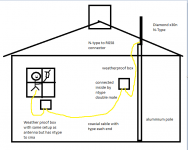hi all
Help about to get a new hobby!
New to this got license some 4 / 5 months ago although my little handheld poor transmit, never actually talked to anyone yet.
I think have settled on something like a diamond x30 n as it appears to be the only on in stock around and one the cheapest. I notice however they come with an N or an So239, My questions are:
- is a diamond x30n right for me
-N or SO239 which one is best?
- If an So239 which connector
- which coax?
New amateur so assuming 2m is best for me
So Assuming so39 is more common but appears to be a thousand connectors. I was going to get some cheap coaxial from screwfix which i think is called RG6 but for the life of me I cant find any pl239 to RG6, plenty of RG6 or RG8 but nothing that actually confirms will fit the coax. Am i looking at wrong coax? i dont really want to be buying the gold standard coax just yet as I have yet to even get on the air yet.
I am on tight budget so dont want to buy 10 different connectors to only find they dont fit or rubbish signal.
I only have a little 5w handheld to play with which has an SMA connector so assuming the same sort of connector pl239 or such with an extension to SMA should suffice.
This is intended to go outside so as waterproof as possible connectors, can anyone help?
Thanks
Help about to get a new hobby!
New to this got license some 4 / 5 months ago although my little handheld poor transmit, never actually talked to anyone yet.
I think have settled on something like a diamond x30 n as it appears to be the only on in stock around and one the cheapest. I notice however they come with an N or an So239, My questions are:
- is a diamond x30n right for me
-N or SO239 which one is best?
- If an So239 which connector
- which coax?
New amateur so assuming 2m is best for me
So Assuming so39 is more common but appears to be a thousand connectors. I was going to get some cheap coaxial from screwfix which i think is called RG6 but for the life of me I cant find any pl239 to RG6, plenty of RG6 or RG8 but nothing that actually confirms will fit the coax. Am i looking at wrong coax? i dont really want to be buying the gold standard coax just yet as I have yet to even get on the air yet.
I am on tight budget so dont want to buy 10 different connectors to only find they dont fit or rubbish signal.
I only have a little 5w handheld to play with which has an SMA connector so assuming the same sort of connector pl239 or such with an extension to SMA should suffice.
This is intended to go outside so as waterproof as possible connectors, can anyone help?
Thanks


